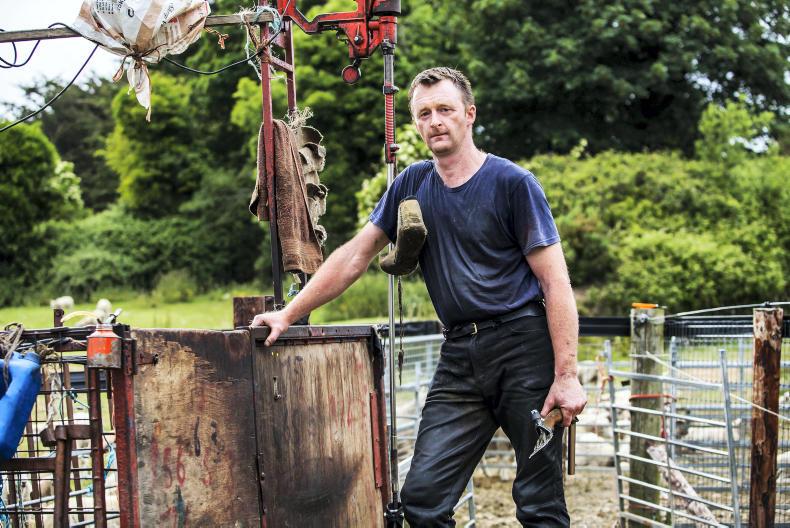I’m blessed really, all my shearing is within a half an hour of me, all around Roundwood, Co Wicklow. I’m probably luckier than most shearers, I don’t have far to travel at all, it’s right beside me.
Listen to "Joe Malone, shearer" on Spreaker.
I have sheep and sucklers myself. We’ve about 40 sucklers and 500 ewes. 
Mostly, I lamb them all inside. This year, I lambed a batch of singles outdoors. If the weather was right now I’d lamb more outdoors, well, singles anyway. The twins are all lambed in.
I lamb in two divisions. The first batch, the crossbred ewes, would start around the first week in February. Then the Cheviots, they start towards the end of March.
So when one batch is finished, you have about a week or so where you can get to bed a bit earlier and get the pens all cleaned out, before the next batch starts.
Shearing season
You’re finished one job and then you’re straight on to the next. The first shearing we did this year was 15 April, but it’d be generally around the middle of May when it’d kick off. I’d go then until the first week of July maybe.
I could shear for longer, but at the beginning of July I’d be into hay and silage here at home on the farm, so you have to call a halt to it. It’d be all go for the few weeks of shearing.
It’s like anything else, hay and silage would be the same, when the sun is shining everyone wants you the one day.
If you were doing two or three moves a day, which is the norm on a lot of days, you’d be looking at shearing on average between 150 and 200 a day. But it really depends on the sheep.
You need heat to rise wool. On a warm day you can see the wool rising on the sheep and the grease that would be in the wool, you’d hardly have to use any oil on your hand-piece. On a cold day the wool would just dry back into them. You would get it off them, but you would be pushing and shoving.
We do an awful lot of winter shearing December to January, so that’d keep you fit over the winter months. Then in September we’d be shearing lambs, so I’d be at it for a good bit of the year on and off.
Initially at this time of year, the first week back you might be stiff in the evening after a big day, but that’s just down to your muscles needing to adjust again. Once you get over that you’re flying, well, you’d hope to be anyway.

The price of wool is worthless at the moment. The last couple of years it’d hardly cover the cost of the shearing.
Usually the farmer would have to put money with it to pay the shearer, which is a shame because it’s a fabulous product and there’s so much that can be done with wool.
Getting going
I learned how to shear from my father in the very beginning. As the years went on then I served my time with Henry Moore and the late Pat Coffey. I did courses too and I’d have done a bit with George Graham back in the day.
The best advice I was ever given was by a local man. He told me years and years ago when I was starting first, if I go into a place and sheep aren’t fit (the wool is easy to take off), don’t hesitate to turn off your machine and leave.
At the end of the day, you’re the one shearing them and if they’re not fit just come back to them in a week or a fortnight’s time.

That still sticks in my mind anyway, because I remember when I started initially, you go in and you’re just mad for it. You get it off of them whatever way you can.
I do a few competitions every year, normally. The competitions and shows have a great buzz and you meet great people. You’d strike up good friendships. There are lads you mightn’t see from one end of the year to the next. It’s quite social, you might meet up for a few pints at night time.
The June bank holiday next weekend would have been the All-Ireland Shearing in Ballyshannon, Co Donegal. I usually go every year for the weekend and I compete in the senior competition as well. Unfortunately it’s cancelled this year, so there’s nothing really to look forward to. But hopefully next year now we can get back there.
Cleanliness is everything in competition. Just because someone’s the first to finish doesn’t mean they’re going to get first place. It’s how well the sheep are shorn. You have judges on the board and judges out the back.

Especially the judges on the board, they’re watching for second cuts, that’s having to go over a stroke or taking off little bits. Judges out the back are looking for any cuts, little nicks or anything like that.
I’m 32 years shearing this year, you can do the maths, I was 48 there a couple of weeks ago. I love it, to be honest with you. When you get into your stride, you get a great buzz off of it. Especially when everything is going well and you meet great people at the farms you’d be going to.
I enjoy it, well, if I didn’t to be honest with you I wouldn’t be at it. Hopefully there’s another few years left in me now.
